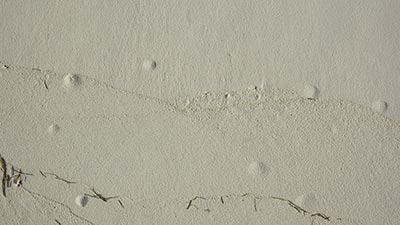What Is Blistering Concrete?
Akin to the type of skin irritation, concrete blisters are hollow, inconspicuous nodules on a concrete surface. Though they’re generally small, usually dime-sized in diameter up to one inch, blisters can grow up to three inches in diameter depending on the situation.
Why Does Concrete Blistering Happen?
It begins when either bleed water or bubbles of entrapped air move through the concrete and are unable to escape the surface. Usually the surface was sealed too early during finishing, resulting in the hidden voids of air and bleed water underneath the mortar skin. While it’s possible for the blisters to develop soon after finishing, they can be difficult to identify in dim and/or poorly lit areas. In this case, the blisters are only detected when they break open after the concrete has cured, frequently under the weight of traffic.
Factors Of Blister Formation
Although blisters are a common cause for delamination of concrete, it’s important to avoid the formation in the first place. It’s generally difficult to repair this defect and other types of concrete defects after the surface hardens. Common factors include:
Excessive Or Insufficient Vibration
With inadequate vibration, entrapped air can’t be released whereas vibrating the screeds too much causes a thick layer of mortar on the surface.
Use Of An Improper Floating Tool
It’s important to test the surface to make sure you’re using the right tool, such as a wood or magnesium bull float, for the surface. Otherwise, an improper floating tool can’t seal the surface which leads to further concrete issues.
Excessive Evaporation Of Bleed Water
When this happens, the surface appears to be ready for final finishing, but the concrete continues to release bleed water and entrapped air. It’s a major problem when the surrounding environment experiences:
- High ambient temperatures;
- High wind speeds; and/or
- Low humidity.
Entrained Air
Whether the entrained air is used or at a higher than normal level, it significantly reduces the quantity and rate of bleed water inside the concrete. In turn, the concrete looks as if it’s ready to be floated and finished but doing so would produce premature finishing.
Cooler Subgrade Than Concrete
The temperature difference causes the surface to set at a faster rate than the bottom concrete, frequently resulting in a premature finish.
Thick Concrete Slab
When the slab thickness exceeds an ideal depth, the bleed water and entrapped air need more time to rise to the surface. This delays overall curing and finishing.
Cohesive Or Sticky Concrete
This situation usually arises when there’s a higher content of cementitious materials or excessive fines in the sand, causing less bleeding and at a slower rate. Yet, lower content levels allow for more rapid bleeding during a shorter time frame but the concrete has a higher total amount of bleeding thus delaying the finish.
Prematurely Applying Dry Shake
This commonly happens with air-entrained concrete.
Placing The Slab On An Impervious Base
Placing a concrete slab over an impervious base, such as a vapor retarder, which prevents the subgrade from absorbing the bleed water.
Can I Prevent Concrete Blisters?
Yes. Use caution if a concrete surface appears to be ready for finishing ahead of the predicted timeline. Any finishing operations should focus on:
- Quickly placing, striking off, and bull floating the concrete; and
- Not creating a mortar layer on the surface.
Once these steps are complete, delay any further finishing if possible. Protect the surface from evaporation with a covering, such as polyethylene. In a situation where high evaporation rates are present, cover a small part of the slab to assess if bleeding is present.
During the initial floating, make sure the float blades are flat which avoids premature densification of the surface. In cool weather, using an accelerating admixture or heated concrete frequently prevents blister formation. Also, it’s recommended to use non-air entrained concrete for interior slabs, but not to steel trowel any air entrained concrete.
Tips To Avoid Concrete Blistering
- Don’t seal the surface before air and/or bleed water have escaped from the concrete below.
- Don’t use dry shakes on air-entrained concrete.
- In cooler weather, using accelerated or heated concrete promotes even setting throughout the slab depth.
- If vapor retarders are required, refer to CIP 28 to avoid premature finishing. Otherwise, never place a slab directly on a vapor retarder.
- Take steps to protect the concrete from premature drying and/or evaporation.
- For slumps more than five inches, don’t use excessive vibration, such as a vibratory screed.
- Don’t steel trowel air-entrained concrete. If use is necessary based on project specifications, use extreme caution when timing the finishing.
What Can I Do If Concrete Blisters Form?
Generally, there are two options to choose from. You can flatten the trowel blades or use a wood float to rip the surface then stall finishing as long as possible. If the current conditions cause rapid evaporation, the rate may be slowed between finishing steps by:
- Using wind breaks;
- Misting the surface with water;
- Adding evaporation retarders; and/or
- Covering the surface with polyethylene film or wet burlap.
Refer to ACI 302.1R and ACI 305 for additional suggestions.


